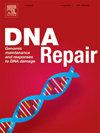Overexpression of the WWE domain of RNF146 modulates poly-(ADP)-ribose dynamics at sites of DNA damage
IF 2.7
3区 生物学
Q2 GENETICS & HEREDITY
引用次数: 0
Abstract
Protein poly-ADP-ribosylation (PARylation) is a post-translational modification formed by transferring successive units of ADP-ribose to target proteins to form poly-ADP-ribose (PAR) chains. PAR plays a critical role in the DNA damage response (DDR) by acting as a signaling platform to promote the recruitment of DNA repair factors to the sites of DNA damage that bind via their PAR-binding domains (PBDs). Several classes of PBD families have been identified, which recognize distinct parts of the PAR chain. Proteins encoding PBDs play an essential role in conveying the PAR-mediated signal through their interaction with PAR chains, which mediates many cellular functions, including the DDR. The WWE domain, encoded in 12 human proteins, identifies the iso-ADP-ribose moiety of the PAR chain. PARylation is a heterogeneous structure that is highly dynamic in cells. Capturing the dynamics of PARylation is essential to understanding its role in the DDR, which can be achieved by expanding the tool kit for PAR detection and tracking mediated by the unique binding capability of various sensors. We recently described the WWE domain of RNF146 as a robust genetically encoded probe, when fused to EGFP, for the detection of PAR in live cells. Expanding on this, we used structural prediction tools to evaluate all of the WWE domains encoded in human proteins, evaluating each as molecular PAR probes in live cells. We demonstrate unique PAR dynamics when tracked by WWE-encoded PAR binding domains, in addition to an engineered macrodomain, that can be exploited for modulation of the PAR-dependent DNA damage response.
RNF146的WWE结构域的过表达可调节DNA损伤位点的多核苷酸动力学
蛋白质多adp核糖基化(PARylation)是一种翻译后修饰,通过将连续的adp核糖单位转移到靶蛋白上,形成多adp核糖(PAR)链。PAR在DNA损伤反应(DDR)中起着至关重要的作用,它作为一个信号平台,促进DNA修复因子通过其PAR结合结构域(PBDs)聚集到DNA损伤位点。已经确定了几种PBD家族,它们识别PAR链的不同部分。编码pbd的蛋白质通过与PAR链的相互作用在传递PAR介导的信号中发挥重要作用,PAR链介导许多细胞功能,包括DDR。WWE结构域编码于12种人类蛋白质中,用于识别PAR链的isoadp -核糖部分。PARylation是细胞中高度动态的异质结构。捕获PARylation的动态对于理解其在DDR中的作用至关重要,这可以通过扩展各种传感器独特的结合能力介导的PAR检测和跟踪工具包来实现。我们最近将RNF146的WWE结构域描述为一种强大的遗传编码探针,当与EGFP融合时,用于检测活细胞中的PAR。在此基础上,我们使用结构预测工具来评估人类蛋白质中编码的所有WWE结构域,并将每个结构域作为活细胞中的分子PAR探针进行评估。我们展示了通过wwe编码的PAR结合域和工程大结构域跟踪的独特PAR动态,这些结构域可用于调节PAR依赖的DNA损伤反应。
本文章由计算机程序翻译,如有差异,请以英文原文为准。
求助全文
约1分钟内获得全文
求助全文
来源期刊

DNA Repair
生物-毒理学
CiteScore
7.60
自引率
5.30%
发文量
91
审稿时长
59 days
期刊介绍:
DNA Repair provides a forum for the comprehensive coverage of DNA repair and cellular responses to DNA damage. The journal publishes original observations on genetic, cellular, biochemical, structural and molecular aspects of DNA repair, mutagenesis, cell cycle regulation, apoptosis and other biological responses in cells exposed to genomic insult, as well as their relationship to human disease.
DNA Repair publishes full-length research articles, brief reports on research, and reviews. The journal welcomes articles describing databases, methods and new technologies supporting research on DNA repair and responses to DNA damage. Letters to the Editor, hot topics and classics in DNA repair, historical reflections, book reviews and meeting reports also will be considered for publication.
 求助内容:
求助内容: 应助结果提醒方式:
应助结果提醒方式:


